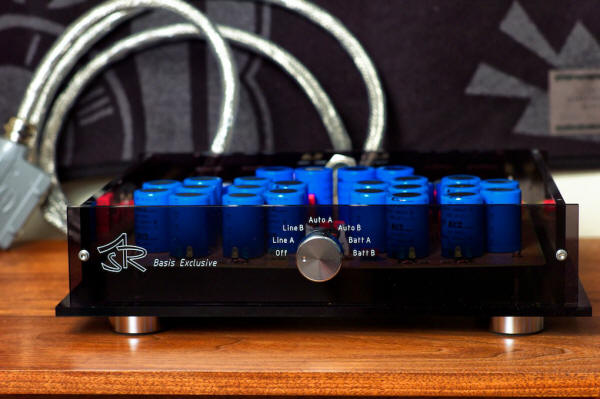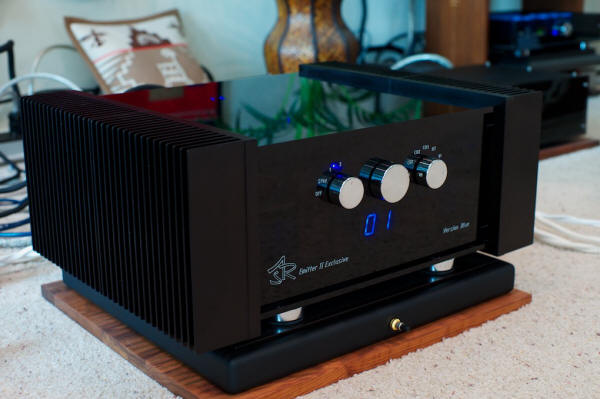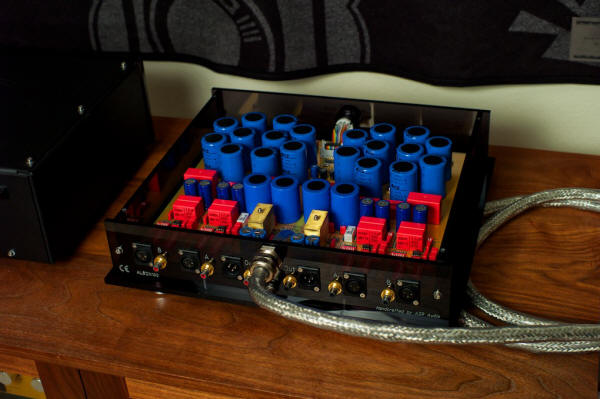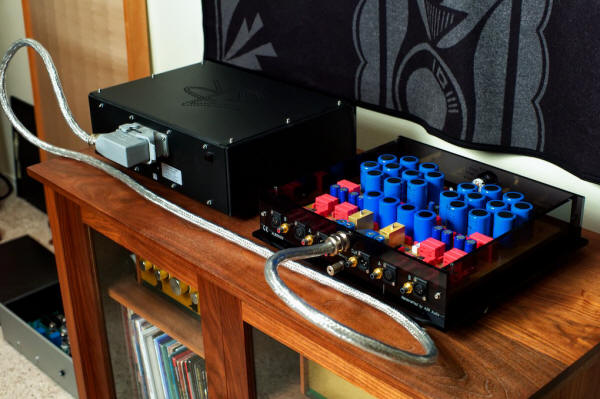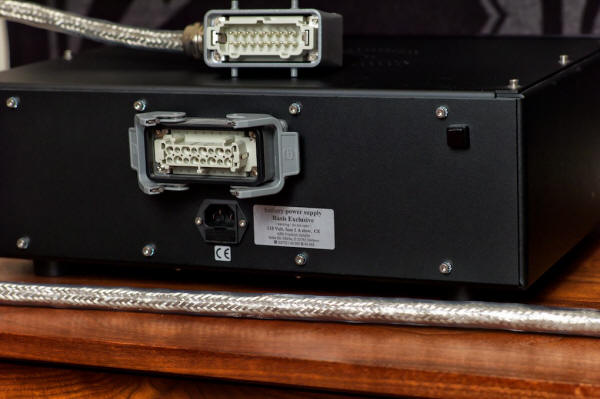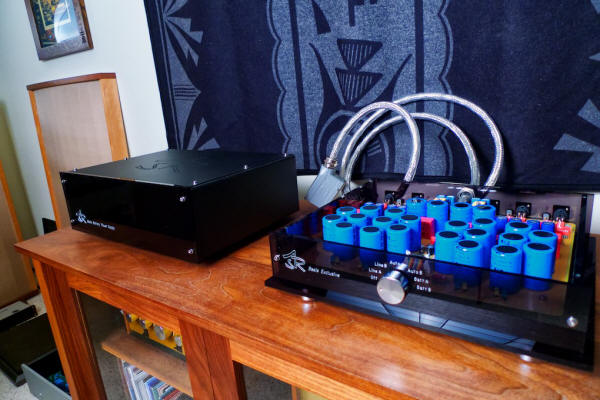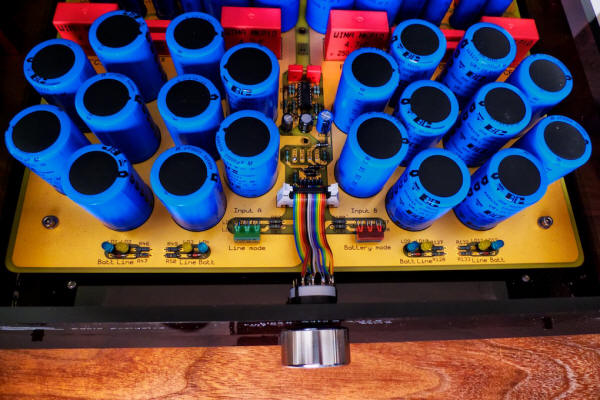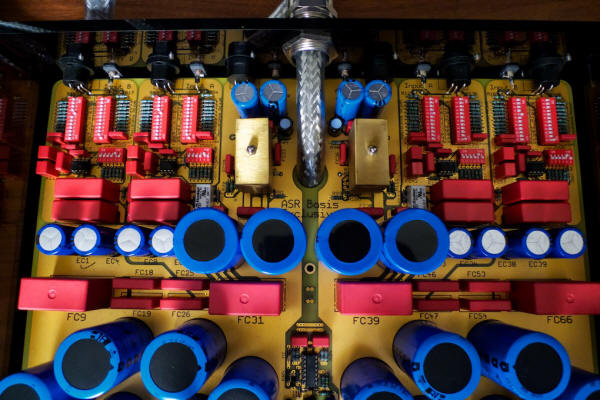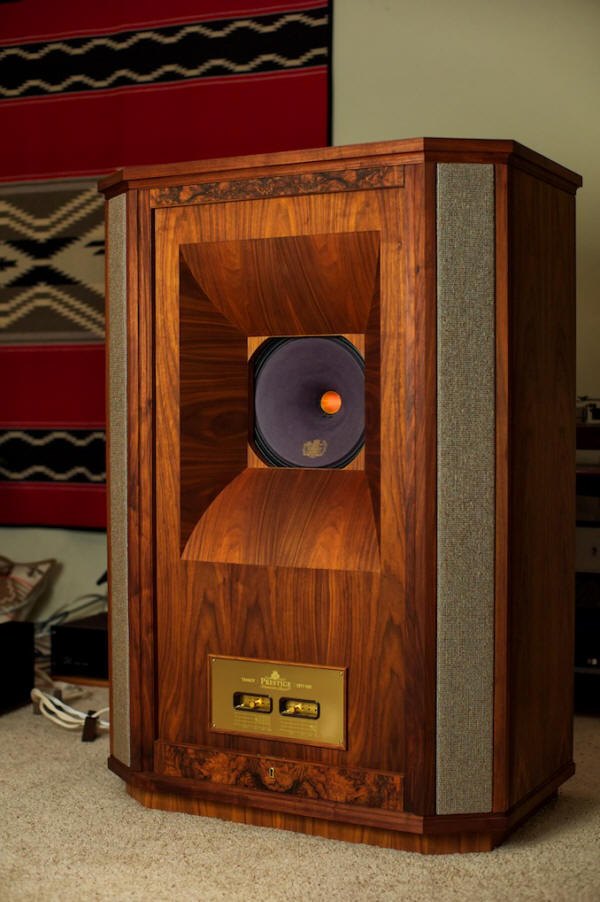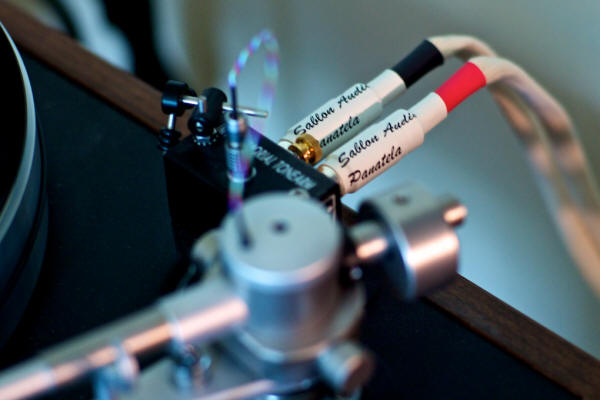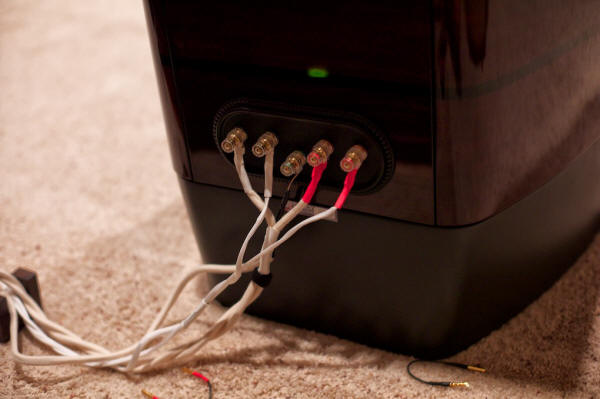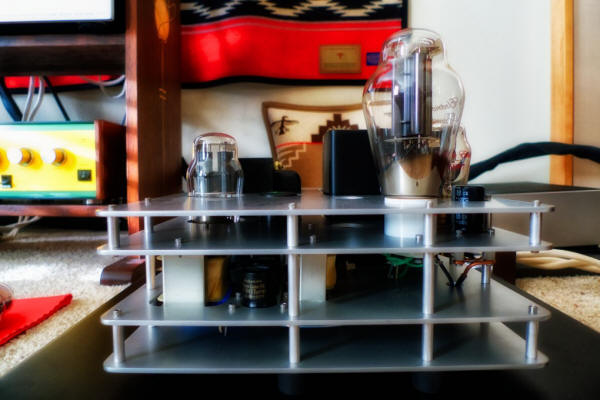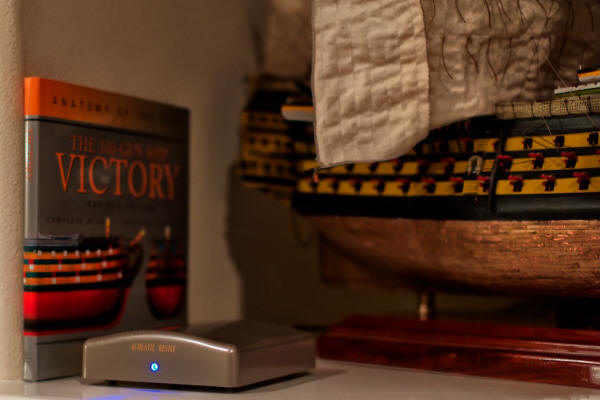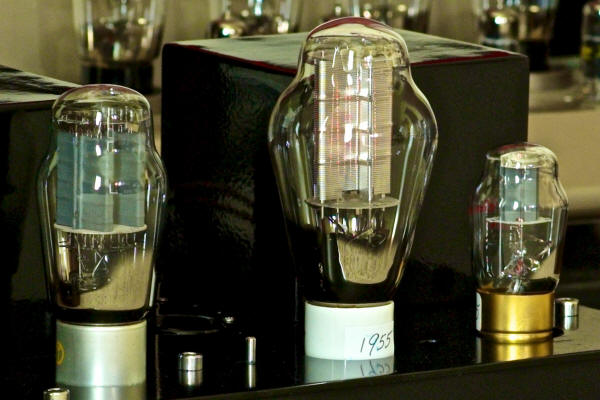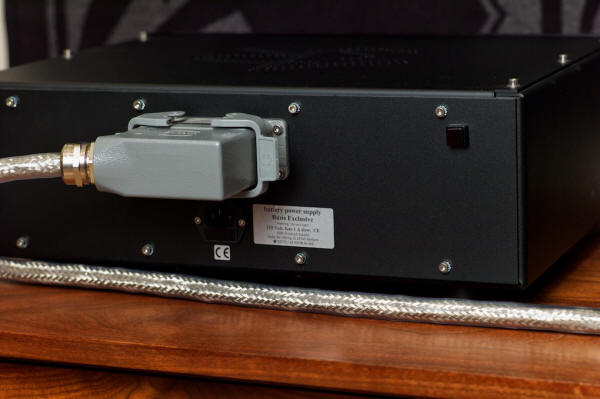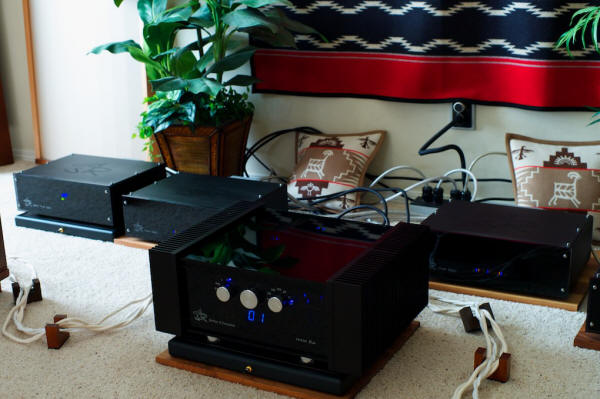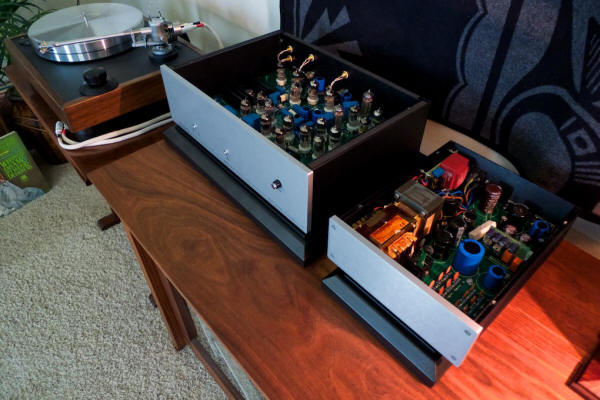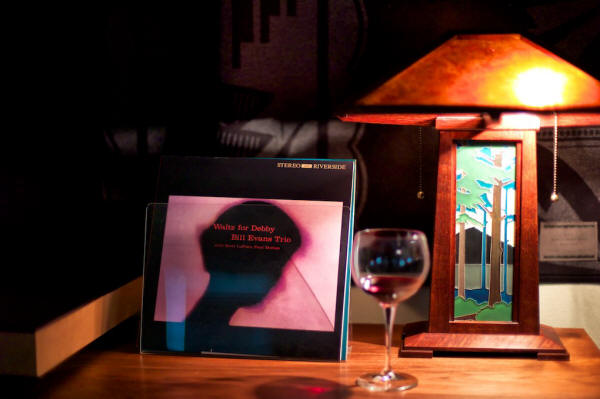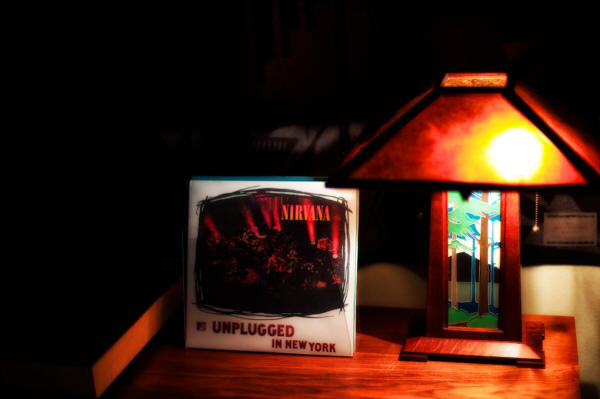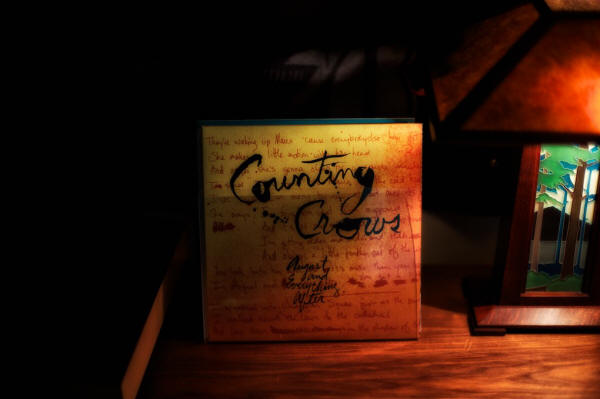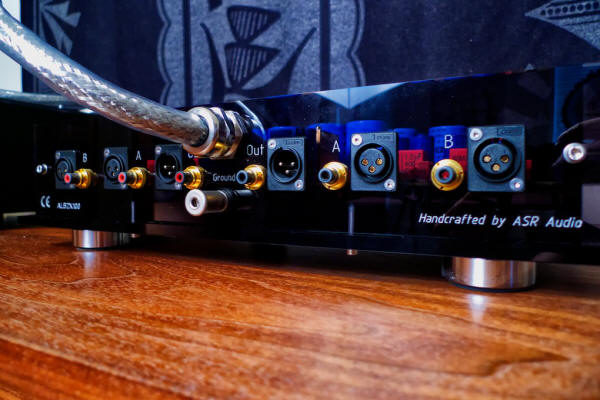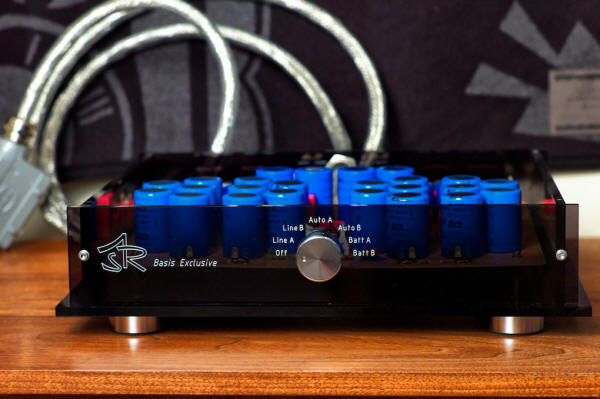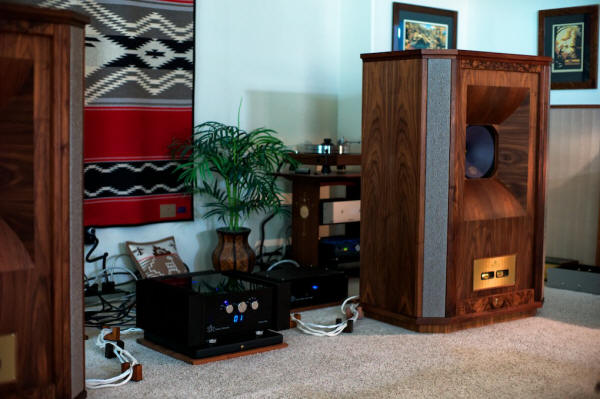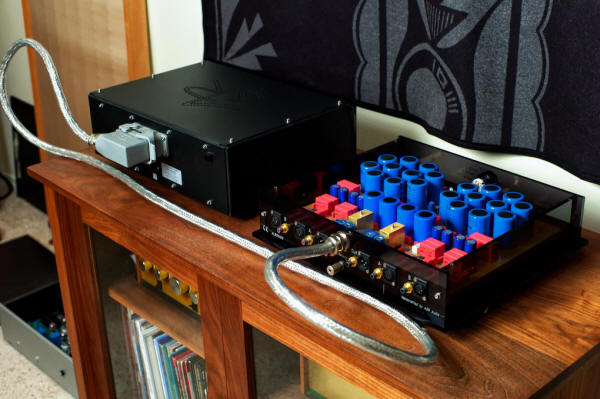|
You are reading the older HTML site
Positive Feedback ISSUE 67
The ASR Basis
Exclusive Phono Equalizer
Handcrafted to an extraordinary level of quality in Herborn, Germany, the ASR Basis Exclusive phono equalizer is Friedrich Schaefer's statement battery powered phono equalizer, and it is the intended partner for the ASR Emitter II Exclusive Version Blue amplifier that I reviewed in Issue 66 of Positive Feedback Online, which won my top spot as the most musically satisfying amplifier I've ever had the pleasure of listening to in my Hi-Fi system. Like the Emitter II amplifier, the ASR Basis Exclusive phono equalizer is a remarkable product that will delight those vinyl lovers lucky enough to own one.
Friedrich Schaefer's ASR Audio Systeme Friedrich Schaefer and Michael Rompf founded ASR (Audio Schaefer & Rompf) in 1980, with Friedrich doing all of the design work and Michael the sales. Friedrich's first product for ASR was a loudspeaker in 1980, and then in 1982 he designed the Basis phono equalizer, followed by the Emitter amplifier in 1983. Friedrich's designs proved to be very popular with Hi-Fi enthusiasts, and growing sales success allowed ASR to move into a larger manufacturing space in 1988. In 1994 when Michael left the company Friedrich bought out his interest in it, and with increasing market awareness of the excellence of the ASR electronics, sales continued to increase, and in 2000 ASR was able to move into an even larger manufacturing space that provided nicer conditions for everyone working at ASR. It turns out that Friedrich's employees aren't the only ones that are happy about all things ASR, as Friedrich's customers around the world are very enthusiastic for both the ASR electronics and Friedrich's personal touch that makes his customers feel like friends of the ASR family, and as Friedrich tells me, "Many of our customers have become my friends, and they tell me how much fun they have listening to music with ASR products, which I've designed to enrich people's lives with music." I did a high level overview of the ASR product line in the review of the Emitter II Exclusive Version Blue amplifier, which I will not repeat here for brevity's sake, and I refer you there for more information. The ASR Basis Exclusive Phono Equalizer The Basis Exclusive is Friedrich's statement phono stage. The version of the Basis Exclusive I reviewed was completely redesigned in 2010, and is referred to as the "2010 Model". The Basis Exclusive was designed for those with two tonearms on their turntable, or two turntables, and on the back panel you'll find two pairs of unbalanced RCA stereo inputs, two pairs of balanced stereo XLR inputs, and inside there is corresponding dedicated and fully balanced MM/MC pre-amplifier circuitry for each input (two full sets of MM/MC pre-amplifier circuitry) so you can switch tonearms or turntables on the fly.
The Basis Exclusive consists of two chassis connected by a giant umbilical cable that is hardwired to the main chassis and connects with a multi-pin connector to the battery power supply.
The main chassis of the Basis Exclusive houses all of the sensitive phono-preamplifier circuitry, and as with the Emitter II Exclusive Version Blue, Friedrich constructs the main chassis of the Basis Exclusive from acrylic glass (e.g. transparent plastic). Friedrich says he chose acrylic glass because it is more rigid and resonance-free than metal, as well as having no electrical & magnetic influences on circuitry components the way metal can, which he says results in an audibly more neutral and smooth sounding reproduction of music. I think the acrylic glass is quite beautiful visually, and I found it fun & intriguing to see the components inside the Basis Exclusive. So while Friedrich chose acrylic glass because it performs better and enhances sound quality, I also found it to be a very attractive way to showcase the ultra-quality of the components & construction that are evident inside the Basis Exclusive.
On the front panel of the main chassis is a rotator switch that has an "Off" position; a "Line A" or "Line B" position that keeps the Basis Exclusive powered up by supplying current from the charging transformer; an "Auto A" and "Auto B" position that keeps the Basis Exclusive powered up by supplying current from the charging transformer until the circuitry senses an output signal higher than 100 mV, then it switches the Basis Exclusive into battery mode; and a "Batt A" and "Batt B" position that powers the Basis Exclusive's circuitry from the external battery power supply only, while disconnecting the charging transformer from the AC supply for the purest electrical supply possible.
There are a series of monitor LEDs visible through the front acrylic faceplate that indicate what mode the Basis Exclusive is operating in. For example, when "Line" A or B is selected a yellow LED illuminates, or when "Batt" A or B operation is selected on the rotator switch, an additional blue LED illuminates. If input A is selected a green LED illuminates, and input B is selected a red LED illuminates, etc. Full descriptions of all the monitoring LEDs are described in the owner's manual. In the photo above you can see the LEDs lining the front of the circuit board in front of the capacitors.
Friedrich used a double-sided layered circuit board with "two very thick 105 µ copper-lead layers" in the Basis Exclusive. In the signal path Friedrich used only polypropylene and polystyrene capacitors, and foil capacitors are used to buffer the operational voltage. In the main chassis there is more than 860,000 µF of capacitors, and together with battery power supply there is over 1,300,000 µF. I asked Friedrich if he would provide a "walk-through" of the circuit for the Basis Exclusive: Friedrich told me that he designed the Basis Exclusive with a balanced input to reflect the design of phonograph cartridges, saying, "… a cartridge is a perfect balanced source like a microphone, and therefore we are using a special microphone preamplifier circuit sourced from a company that makes integrated circuits designed specifically for audio use. So the input stage is fully balanced and provides linear amplification of the input signal." The Basis Exclusive offers a variety of adjustments to optimally tailor each input stage to a different cartridge so no readjustment is necessary when switching between two tonearms or turntables. Gain is adjustable from 32dB to 70dB; input resistance is adjustable from 10 to 20,000 Ohms in balanced mode and 5 to 47,000 Ohms in unbalanced mode, and can be switched separately for the positive and negative part of the signal between the plus input and ground and the minus input and ground; input capacitance is adjustable from 100 to 570 pF; and low frequency cutoff can be set from 2 to 20Hz to help optimize bass output for your Hi-Fi system. You can see the various DIP switches used to make the adjustments towards the top of the circuit board in the photo above. Friedrich said that having two separate input stages not only has the advantage of individual adjustment, but also there are no switches or relays in the input signal path, so the full signal quality is preserved. "Only after the first stage where you have a much higher signal with a very low impedance is the signal switched between the two inputs using relays. This solution is sonically much better than switching at the input." Friedrich told me that, "After the input selection relay the signal then passes through filters to provide the necessary coefficients for RIAA equalization. These two filters are at the extremes of the frequency range: The first one is for very low frequencies, to cut away rumble frequencies below 20Hz. This filter is switchable to 2Hz for even better low frequency performance in the case where the phono cartridge or tonearm you are using has no low frequency resonances. The second filter is at the other end of the frequency range and damps high frequencies above 2122Hz." Friedrich went on to say, "After this, the signal goes into the second stage that is a high-quality and low-noise op-amp. There is a very moderate active filter at 500Hz built in, which means that you get a very low gain variation from this stage. With its very low output impedance the op-amp drives the unbalanced output directly without any resistors in signal path, and the offset of the output stage is regulated. The negative signal part of the balanced output is made with a phase inverter."
The second chassis of the Basis Exclusive houses a massive battery power supply. I asked Friedrich to tell us a little about it: "At first the ASR Basis Exclusive works from batteries located in a separate large outboard power supply that has a buffering capacity that is normally only used for large amplifiers. Although you need only very low power from a phono equalizer for a typical preamplifier input—only some milliamps—but to get a very stable signal and to get the best possible working conditions for the amplification circuitry the large outboard power supply provides great benefit." "The signal of some low output moving coil cartridges is sometimes only a millionth of a volt, so it has to be amplified a million times or more. So even a very low hum from the turntable of even a millionth part of a volt can result in an audible and annoying noise at the speaker that can destroy the pleasure of listing to the music. So the best solution is to not have any humming in a phono stage! The way to do that is to use a stable storage device like a rechargeable battery. I use 6 large lead-acid gel batteries in the separate power supply unit to accomplish this. From my over 30 years of experience with battery driven audio amplification, I have found that the lead-acid gel batteries are the best solution for this purpose. Batteries are not perfectly quiet either, as they have some noise, and so I use a filter and a huge buffering capacity to make it very quiet. I place large capacitors in the separate battery power supply, but even more in the main chassis of the Basis Exclusive, for more than 1,300,000 µF of buffering." Friedrich chooses to locate the power supply outside the main chassis of the Basis Exclusive to eliminate AC interference, EMI radiation, and transformer vibration issues from the power supply, so that the signal-to-noise ratio in the sensitive amplification circuitry inside the Basis Exclusive main chassis is as low as possible. The other reason Friedrich places the power supplies outside the main Basis Exclusive chassis are—as you read above—because he believes in using a massive power supply for the ultimate in performance, and they are just too big to fit inside the main chassis. The external battery power supplies for the Emitter II Version Blue amplifier and the Basis Exclusive phono equalizer are similar in concept and the number of batteries utilized, but they are not interchangeable, as they utilize different voltages & capacitance values to power the input stage of the Emitter II and the phono amplification circuitry of the Basis Exclusive. The battery power supply contains six 6-Volt / 12-Ampere-hours batteries and 440,000µF of capacitor buffering. Friedrich says the outboard battery power supply contains a "highly sophisticated & complex charging & monitoring circuitry… in fact the inside of our battery unit looks more like a powerful amplifier than a simple battery-cell compartment." The circuitry automatically monitors & charges the batteries as needed, monitors the batteries output, and filters & stabilizes the voltages that are supplied to the phono equalizer circuitry of the Basis Exclusive. Friedrich built signal detection into the Basis Exclusive to maximize the life of the batteries. Friedrich says, "In the ‘Auto' mode, when you play a record the Basis Exclusive, it works in battery mode, and when the music pauses it switches back into battery charging mode. If the output signal is higher than 100 mV the Basis Exclusive detects it and switches into battery mode. After about 3 minutes without signal the Basis Exclusive switches back into battery charging mode." On the faceplate of the power supply a series of different colored LEDs indicate its operational status (yellow = charging, green = charged, red = standby, etc.). Once fully charged, the batteries will power the Basis Exclusive for about 60 hours of playing time, much more than any listening session is likely to last. If you leave the Basis Exclusive in the "Auto" position it will automatically charge the batteries so you will always have a full charge to play music with. Friedrich recommends that the batteries be replaced every 5 to 7 years of use, which is a "plug and play" swap, utilizing commercially available batteries, with a modest replacement cost of approximately $100 USD for the set of six batteries. All of the ASR amplification products come with an AC power cord called the Magic-Cord Active that is an active device that decouples DC from the AC source in order to minimize or eliminate transformer hum. When you purchase an ASR Basis Exclusive phono equalizer it is custom built according to your specific needs as a user. The Basis Exclusive's base price in the USA is $9,600 USD. Optionally, you can choose to add WBT silver RCA connectors, Argento Audio silver XLR connectors, rhodium fuses for the battery power supply, and a mono switch located in the front or rear panel. The ASR Basis Exclusive reviewed had the optional WBT silver connectors, which is a $710 USD option. Total price for the ASR Basis Exclusive as reviewed comes in at $10,310 USD. Review System To gather listening impressions for the ASR Basis Exclusive phono equalizer I used my usual front-end combination of an EMT TSD-15 phono cartridge mounted on a VPI Classic turntable. For comparators in phono equalization I used the New Valve Order SPA-II and the New Valve Order SPA one (in for review). In addition to the Basis Exclusive's intended partner, the ASR Emitter II Exclusive Version Blue amplifier, I also used the Leben RS-100U line preamplifier, paired with either my Sophia Electric 91-01 300B mono amplifiers or my Fi 300B mono amplifiers, to see how well the Basis Exclusive fared in a different amplification context. For loudspeakers I used the Tannoy Kingdom Royal loudspeakers (during the time I had them in for review), and of course my usual reference Tannoy Westminster Royal SE loudspeakers.
I used the Sablon Audio Panatela interconnects for all my front-end components and the Sablon Audio Panatela component speaker cables for my Westminster Royal SEs (and the Kingdom Royals). From the phono stages or Leben RS-100U line stage, to the amplifiers used during the review, I used a long run of Acoustic Revive Single Core interconnects (in for review).
For my turntable, non-ASR phono equalizers, the Sophia Electric 91-01 300B mono amplifiers, and the Fi 300B mono amplifiers I used either the new Sablon Audio Petit Corona power cords (in for review), Sablon Audio Robusto, Sablon Audio Grand Corona, or the Acoustic Revive Power Reference power cords depending on which one provided for the most complimentary match at the time. All power cords were plugged into either an Acoustic Revive RPT-2 or RPT-4 Ultimate Power Distributors and connected to wall receptacles with the Acoustic Revive Power Reference power cables.
I use one of Alan Kafton's Audiodharma Cable Cooker devices to condition all of the cables in my system for best performance (personal purchase, no review). I also use quite a number of the very effective Acoustic Revive accessories to optimize performance of the system in my primary listening room as described in the Acoustic Revive Chronicles chapters (1, 2, 3, 4, 5, 6, 7, 8, 9).
Listening Impressions I already knew the ASR Basis Exclusive phono equalizer was a superb match with the ASR Emitter II Exclusive Version Blue amplifier from earlier reviews, and after all, they were designed to complement each other —and they do that spectacularly well. So I decided to start my listening sessions for the Basis Exclusive review by pairing the Basis Exclusive with the Leben RS-100U vacuum tube line preamplifier, the Sophia Electric 91-01 300B mono amplifiers, and then the Fi 300B mono amplifiers, to see what I could learn about it in different amplification contexts.
One of the most notable conclusions I came to when listening to music with the ASR Basis Exclusive combined with the Fi and Sophia Electric 300B amplifiers, was how much of a positive difference that huge battery power supply of the Basis Exclusive makes to overall performance on dynamics in the music.
With the other phono equalizers I had on hand, I thought the Fi and Sophia Electric 300B amplifiers were running out of power to track the biggest dynamic peaks in the music, but that turned out largely not to be the case. Rather, with the ASR Basis Exclusive and its huge power supply almost all of that sense of the 300B amps running out of power disappeared—the Sophia Electric and Fi 300B mono amps seemed like different amps with a new lease on life from a dynamic standpoint. I was shocked at how much of a difference it made, and I certainly didn't expect that breath of dynamic ease to extend from the Basis Exclusive to the 300B amplifiers, but it largely did. As a result, I'll never look at power supplies quite the same way again, and after hearing what the ASR electronics with their emphasis on huge power supplies are capable of, I can't help but wonder if almost all audio electronics are being strangled in their ultimate performance by the use of power supplies that are too small. So while I did say that almost all of that sense of the 300B amps running out of power on dynamic peaks disappeared, I did not say all. It's clear that the ASR Emitter II Exclusive Version Blue amplifier with its huge power supplies and ability to put 250 watts output into the Westminster Royal SE loudspeakers 99dB sensitivity and 8 Ohm impedance, had an ease on dynamic peaks in the music that was quite addictive, easily besting my cherished 300B amplifiers.
With the 300B amps I also noticed how neutral, clean, and clear sounding the Basis Exclusive phono equalizer is. With the smooth & natural sound of the ASR Emitter II Exclusive Version Blue amplifier, that's pretty much the sound I heard when it was combined with the Basis Exclusive—smooth and natural, while being sonically & musically engaging. When the Basis Exclusive was combined with the brighter and more detailed Fi 300B mono amplifiers, everything sounded sublime on really good recordings, but could get a bit bright and brash on less well-recorded material. With the more classically voiced Sophia Electric 300B mono amplifiers their lusher and warmer sonic signature came through unscathed when combined with the Basis Exclusive. So what's the message here? Well, I'd say its that the Basis Exclusive is going to give you a neutral, clean, and clear view into what your other gear sounds like, while imparting little coloration of its own to the music. Its neutrality makes the Basis Exclusive a bit of a chameleon, and what I heard when switching amps was primarily a clear view into what each amp sounded like in my system more than any particular trait of the Basis Exclusive. If you want to buy a Basis Exclusive to either wake up a laid back system, or to mellow out a brash system, you're barking up the wrong tree. Rather, the Basis Exclusive will give you a clear view into what colorations are common to the rest of your system, more than it will imprint any colorations of its own upon it. Actually, I'd say that's a pretty impressive feat, and one that removes another veil to getting good sound out of a Hi-Fi system. Ok, now that I've talked about two of the Basis Exclusive's most obvious traits—its impressive & effortless dynamic prowess, and its neutral & chameleon-like nature when combined with other electronics—let's move on and talk about its sonic and musical performance in a broader sense, using the ASR Emitter II Exclusive Version Blue amplifier as the reference amplification source.
My primary comparator for the ASR Basis Exclusive was the New Valve Order SPA-II ($6500 USD), which is a remarkably good phono equalizer designed by Andreas Hadjiminas in Cyprus, that is my current reference, and which also utilizes a large outboard power supply to energize its 22 vacuum tubes. Andreas, like Friedrich, emphasizes the importance of the power supply to ultimate performance, and the NVO SPA-II power supply is dual mono, is housed in a separate chassis, uses two tube plate regulators per channel, has "ample filtering", and utilizes star grounding. All heaters are regulated DC. I listened to a lot of records with these two fine phono equalizers over the months that I've had the ASR Basis Exclusive here for review, and I think I can offer some useful observations about its overall voicing and relative strengths. To be fair, the ASR Basis Exclusive had somewhat of an advantage in comparisons over the NVO SPA-II because it is voiced to be complementary to the Emitter II Exclusive Version Blue amplifier that I used as the primary reference during the review period, so you'll have to make a little bit of an allowance for that. You might think the Basis Exclusive would have a certain set of predictable traits because its circuitry is based on solid state devices, and that the SPA-II would have a certain set of predictable traits because its circuitry is based upon vacuum tubes, but I think you might be surprised to learn that their performance wasn't really stereotypical of the amplification devices used in their circuitry, as you'll discern as you read between the lines below.
The overall aural perspective of the ASR Basis Exclusive doesn't put the listener as close to the live performance recorded for Bill Evans Trio's Waltz for Debby album as does the New Valve Order SPA-II, but it does offer a smooth, clean, clear, and articulate presentation of recorded detail that has a relaxed sense of ease about it that makes it easy on the ears and a pleasure to listen to. Listen to it for a while and I think you'll begin to crave its presentation—I did. Photo buffs might want to think of the ASR Basis Exclusive as a Leica Summicron M 35 mm / f2 lens, and the New Valve Order SPA-II as a Leica Summicron M 50 mm / f2 lens, as an analogy to these two phono equalizers overall aural perspective. While both these Leica lenses have ultra quality, the Summi 35 lens puts the scene a couple of steps further away than the Summi 50 lens through my M9, and that's just what the Basis Exclusive and SPA-II do too through my Hi-Fi rig. Its not a lot of a difference but it is noticeable, and the Basis Exclusive puts you further back from the performance, and the SPA-II closer. I found both of these perspectives equally satisfying when listening to music.
While these two phono equalizers share a similar amount of detail recovery from recordings (both excellent), the way the SPA-II resolves those details has a little more structure, contrast, and tonal color saturation on the live Nirvana Unplugged album, for example, making the SPA-II sound more vivid & energetic than the Basis Exclusive, which correspondingly sounds more laid back and relaxed.
The SPA-II's more contrasty and structured presentation of detail carries over to the way it displays images on the soundstage, where on the Counting Crows' August and Everything After album the images had sharper outlines and more tangible presence. The Basis Exclusive presented a wider soundstage than the SPA-II, but the SPA-II's greater transparency gave a deeper soundstage with a larger sense of acoustic space to the recording, with the correspondingly larger images that you'd expect with the closer perspective. So you might expect the solid state Basis Exclusive to perform superbly on the normal non-musical sonic parameters of recordings like resolution, transparency, soundstage, soundspace, and imaging, and it did, but the vacuum tube New Valve Order SPA-II did it one better in everything but soundstage width. As you know, as important as they are, performance on those non-musical aspects of a recording is only part of the story. The second part of that story is how these two phono equalizers perform on the musical content of recordings like timbre, melody, harmony, rhythm, tempo, dynamics, and loudness. Performance on the musical content of a recording is equally (or more) important. Let's talk about how well these two photo equalizers do on timbres. On Bill Evans Trio's Waltz for Debbie album, from a timbral perspective, both the ASR Basis Exclusive and NVO SPA-II provide textures and tone colors that are believable for the aural distance they place you from Bill Evans' piano, Paul Motian's drums, and Scott LaFaro's bass, and as such their timbral realism is just fine, but they do sound quite different. For example, the decay of notes before they fade into blackness is longer on the SPA-II than with the Basis Exclusive. The Basis Exclusive is cleaner sounding and has more bell-like clarity to the notes from Bill Evans' piano, emphasizing the first strike of the hammer more, than does the SPA-II, which presents a more complex unfolding and decay of a musical note. The cymbals of Paul Motian's drums don't have quite the sense of shimmer through the SPA-II that they have through the Basis Exclusive, and Scott LaFaro's bass, while still articulate, sounds a little sloppier and more robust through the SPA-II than it does through the Basis Exclusive. While I would say both of these phono equalizers possess a high degree of timbral fidelity, the Basis Exclusive presents the instruments as cleaner, clearer, and more relaxed sounding, where the SPA-II presents the instruments as more complex in texture & color, and more vivid overall. I would say that the NVO SPA-II comes closer to what instruments sound like to me in a live performance, but the Basis Exclusive isn't far behind. Through both the ASR Basis Exclusive and the NVO SPA-II I enjoyed the portrayal of the rhythm, melody, tempo, and harmony elements of music, but the ASR Exclusive was more musically compelling in its presentation and allowed me to immerse myself in the emotional content of the music better. To be fair, I thought both these phono equalizers were great performers on these important musical attributes, but the ASR Basis Exclusive was better at making the music and the musicians' technique the focus of my listening sessions, while the NVO SPA-II drew my attention to the sound more often. For example, on Bill Evans Trio's Waltz for Debby, as I listened I could hear Bill's right hand melody line and left hand harmony, and the ASR Basis Exclusive portrayed it beautifully, smoothly and naturally. With the NVO SPA-II the melodies sounded a little more vivid, a little more complex in the way notes bloomed, a little more dramatic, and my attention was drawn more to the sound. These differences caused me to focus in more on the sound than I would have liked with the SPA-II, where the Basis Exclusive's more demure presentation tended to keep me focused more on the ebb & flow of the music and its artistic content. It is on these musical attributes where the ASR Basis Exclusive begins to move ahead in performance over the SPA-II with a natural live-like sensibility that I found to be quite enjoyable. The dynamic prowess of the ASR Basis Exclusive made the melodies come alive, and on Debby when Scott LaFaro takes his turn to do a bass solo you hear every little dynamic nuance in a way that made his bass lines absolutely gripping. With the NVO SPA-II LaFaro's bass solo sounded weightier and richer, but less articulate than the Basis Exclusive. Changes in tempo and the way tempo informed the mood of the music was immediately obvious with the ASR Basis Exclusive, with the NVO SPA-II being a little less adept in portraying tempos (but still excellent overall). With Waltz for Debby I marveled at how Bill improvised on every element of the rhythm, harmony, and melody as he played, and I thought the ASR Basis Exclusive opened up windows of understanding into the expressive meaning of Bill's improvisation across those elements. Through the ASR Basis Exclusive you know that you're hearing the jazz of your dreams. This is jazz at its best – its magic music! While the ASR Basis Exclusive and the NVO SPA-II both perform remarkably well in every important sonic & musical characteristic you choose to slice & dice them with, during my evaluation the NVO SPA-II bested the ASR Basis Exclusive in most sonic characteristics, save soundstage width. When comparing these two fine phono stages on their performance reproducing the musical attributes of a recording, the ASR Basis Exclusive gets the better of the NVO SPA-II in the portrayal of tempo, rhythm, and melody, and the ability to play loud in stress-free fashion, but can't quite match the NVO in timbral realism. But there's still more going on here with the ASR Basis Exclusive than those descriptions of sonic & musical attributes allude to, there's a third level of performance that emerged that I have been quite intrigued by. The way that Friedrich has combined the artist's palette of sonic & musical attributes in the ASR Basis Exclusive transcends normal descriptive terminology in a way that I haven't quite come to grips with articulating fully yet. It's not just excellent performance on the sonic or musical attributes of recordings, although the ASR Basis Exclusive certainly does have excellent performance on those attributes (as does the NVO SPA-II). However, it became obvious over the review period that there's a third order of emotional engagement with the ASR Basis Exclusive that's beyond the normal sonic and musical attributes that I normally use to describe the performance of high-fidelity audio equipment with. When you listen to the Basis Exclusive it sounds really good, and it does very good on musical attributes or recordings, but never did I think about its reproduction of sonic or music attributes discretely when listening to music. Rather, I found myself being drawn into the music itself to an unprecedented level, and I found my listening sessions going on and on, and I just didn't want to stop listening to the music. I felt like the ASR Basis Exclusive provided me a direct emotional link to the artists' intents for the music that I have never experienced before save in live music, and I found it opened up new levels of musical appreciation that I have not experienced before with Hi-Fi equipment. Yes, the ASR Basis Exclusive is really good. Summary and Conclusions The ASR Basis Exclusive phono equalizer is impeccably handcrafted in Herborn, Germany to an extraordinary level of quality and performance. With two phono equalizers built upon one chassis the Basis Exclusive offers a switch on the fly capability between two turntables or tonearms that will endear it to analog lovers with multiple front ends. Priced at $10,310 USD the Basis Exclusive is not inexpensive, but for the level of performance and versatility it offers the analog music lover I would say it's a fair price.
The Basis Exclusive has an impressive & effortless dynamic prowess that is unmatched by any phono equalizer familiar to me, and it has a neutral & chameleon-like nature that makes it easy to combine with other electronics while adding little coloration of its own. The Basis Exclusive's reproduction of non-musical recording artifacts of recordings like transparency, soundstage, soundspace, and imaging, are very good, and are impeccably balanced with its excellent ability to reproduce the musical content of recordings like timbre, melody, harmony, rhythm, tempo, dynamics, and loudness. The result is a phono equalizer that transcends normal audiophile considerations and plays music exceptionally well, and will reward the music lover with years of carefree listening pleasure.
In combination with the ASR Emitter II Exclusive Version Blue amplifier, the ASR Basis Exclusive phono equalizer connected me with the emotional content of the music better than anything I have ever had the pleasure of listening to, and I enjoyed this combination more than any other combination of audio electronics I have ever listened to. The ASR Emitter II Exclusive Version Blue amplifier combined with the ASR Basis Exclusive phono equalizer is simply the most musically satisfying combination of audio electronics I have ever come across. The ASR audio electronics are the kind of Hi-Fi equipment that you buy for life, and then retire from considering other audio equipment, while you focus on building your music collection. Tannoy Kingdom Royal and Westminster Royal SE owners should take special note: the ASR Emitter II Exclusive Version Blue amplifier and the Basis Exclusive phono equalizer have a special synergy with those loudspeakers that just has to be heard to be appreciated.
Let me be perfectly candid. If I could have figured out a way to afford to buy the ASR Emitter II Exclusive Version Blue amplifier ($31,220 USD) and the ASR Basis Exclusive phono equalizer ($10,310 USD), I would have done it in a second. They are simply the best audio electronics I have yet to come across for the music lover. If you can afford to buy these fine ASR electronics I recommend that you do so, and you can thank me later for the years of listening pleasure they'll bring you. Most highly recommended. My hat is off to Friedrich Schaefer for what he has wrought in his Emitter II Exclusive Version Blue amplifier and the ASR Basis Exclusive phono equalizer, they are pure musical genius and made listening to music in my home what I've always wanted it to be. Most highly recommended to music lovers everywhere!
For information worldwide about where to purchase the ASR Emitter II Version Blue, please contact Dr. Friedrich Schaefer. In North America please contact Mr. Zed Husain of Musical Sounds, LLC, for more information or to arrange for a purchase. I'd like to thank Friedrich and Zed for making it possible to write about the ASR Emitter II Version Blue for the readers of Positive Feedback Online.
|

